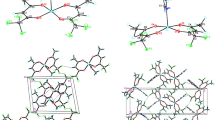Abstract
Schiff-base condensation of a equimolar proportion of diacetyl-monoxime monohydrazone and 1-methylimidazole-2-carboxaldehyde in methanol gives rise to the imidazole azine, 3-(1-methylimidazol-2-yl)methylenehydrazonobutan-2-one oxime(HL). Reaction of 1:1 stoichiometric proportion of HL with copper(II)perchlorate hexahydrate in methanol yields a dimeric oximato bridged copper compound, [Cu2L2(H2O)2](ClO4)2 (1). The compound is characterized by C, H and N analyses, FT-IR, ESI–MS, conductivity measurement, UV–Vis spectra and X-ray single crystal diffraction. The title compound (1) crystallizes in the monoclinic space group P21/c with a = 6.8533 (8), b = 18.413 (2), c = 11.7399 (14) Å, β = 93.685 (2)°, V = 1478.4 (3) Å3 and Z = 2. The geometry around each copper center is distorted square pyramidal. The copper(II) dimer shows antiferromagnetic interaction mediated by symmetric disposition of oximato groups.
Graphical Abstract
A dimeric oximato bridged copper compound, [Cu2L2(H2O)2](ClO4)2 (1), with antiferromagnetic interaction was characterized by C, H and N analyses, FT-IR, ESI–MS, conductivity measurement, UV–Vis spectra and X-ray single crystal diffraction.





Similar content being viewed by others
References
Stamatatos TC, Escuer A, Abboud KA, Raptopoulou CP, Perlepes SP, Christou G (2008) Inorg Chem 47:11825 (and references therein)
Tschugaeff L (1890) Chem Ber 23:1
Chakravorty A (1974) Coord Chem Rev 13:1
Keeney ME, Osseo-Asare K, Woode KA (1984) Coord Chem Rev 59:141
Schrauzer GN (1976) Angew Chem Int Ed Engl 15:417
Kukushkin VY, Pombeiro AJL (1999) Coord Chem Rev 181:147
Biswas B, Salunke-Gawali S, Weyhermüller T, Bachler V, Bill E, Chaudhuri P (2010) Inorg Chem 49:626
Gatteschi D, Kahn O, Miller JS, Palacio F (1991) Magnetic molecular materials. Kluwer Academic Publishers, Dordrecht
O’Connor CJ (1993) Research frontiers in magnetochemistry. World Scientific, Singapore
Gatteschi D, Sessoli R (2003) Angew Chem Int Ed Engl 42:268
Li R, Moubaraki B, Murray KS, Brooker S (2009) Eur J Inorg Chem 19:2851
Hay P, Thibeault JC, Hoffmann R (1975) J Am Chem Soc 97:4884
Kahn O (1993) Molecular magnetism. VCH Publishers, New York
Feig AL, Lippard SJ (1994) Chem Rev 94:759
Que L, True AE (1990) Prog Inorg Chem 38:98
Lippard SJ, Berg JM (1994) Principles of bioinorganic chemistry. University Science Books, Mill Valley
Bruker (2000) SMART (Version 5.0) and SAINT (Version 6.02). Bruker AXS Inc., Madison
Sheldrick GM (2000) SADABS. University of Gottingen, Gottingen
Sheldrick GM (1997) SHELXS97 and SHELXL97. University of Gottingen, Gottingen
Darapsky A, Spannagel H (1915) J Prakt Chem [2] 92:272
Chakrabarti P, Puranik VG, Naskar JP, Hati S, Datta D (2000) Indian J Chem A39:571
Addison AW, Rao TN, Reedijk J, Rijn JV, Verschoor GC (1984) J Chem Soc, Dalton Trans 1349
Murugesu M, Clérac R, Anson CE, Powell AK (2004) Inorg Chem 43:7269
Cage B, Cotton FA, Dalal NS, Hillard EI, Rakvin B, Ramsey CM (2003) J Am Chem Soc 125:55270
Abedin TSM, Thompson LK, Miller DO, Krupicka E (2003) J Chem Soc, Chem Commun 708
Burkhardt A, Buchholz A, Goerls H, Plass W (2006) Eur J Inorg Chem 17:3400
Thakurta S, Roy P, Rosair G, Gómez-Garcia CJ, Garribba E, Mitra S (2009) Polyhedron 28:695
Koumousi ES, Raptopoulou CP, Perlepes SP, Escuer A, Stamatatos TC (2010) Polyhedron 29:204
Stamatatos TC, Vlahopoulou JC, Sanakis Y, Raptopoulou CP, Psycharis V, Boudalis AK, Perlepes SP (2006) Inorg Chem Commun 9:814
Satcher JH, Droege MW, Weakly TJR, Taylor RT (1995) Inorg Chem 34:3317
Tandon SS, Thompson LK, Bridson JN, Dewan JC (1994) Inorg Chem 33:54
Mandal SK, Thompson LK, Newlands MJ, Gabe EJ, Lee FL (1990) Inorg Chem 29:3556
Chaudhuri P (2003) Coord Chem Rev 243:143
Hatfield WE (1972) Inorg Chem 11:216
Acknowledgments
J.P.N. gratefully acknowledges the financial support received from the Department of Science and Technology, Government of India, New Delhi. LPL and MLZ appreciated the National Natural Science Foundation of China (21001070 for Youth), the Scientific Research Foundation for the Returned Overseas Chinese Scholars, State Education Ministry (20093602), the Natural Science Foundation of Shanxi Province (2010011011-2), and Shanxi Scholarship Council of China (200808).
Author information
Authors and Affiliations
Corresponding authors
Rights and permissions
About this article
Cite this article
Naskar, J.P., Biswas, C., Lu, L. et al. Synthesis, Crystal Structure and Spectroscopic Properties of an Oximato Bridged Cu(II) Dimer. J Chem Crystallogr 41, 502–507 (2011). https://doi.org/10.1007/s10870-010-9909-1
Received:
Accepted:
Published:
Issue Date:
DOI: https://doi.org/10.1007/s10870-010-9909-1



